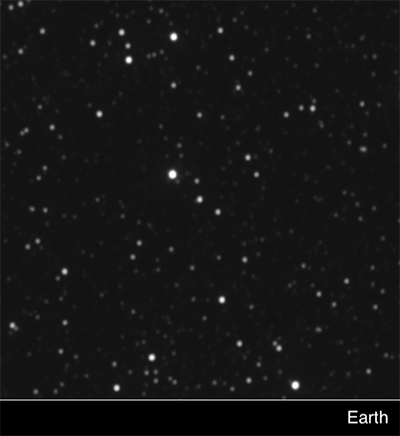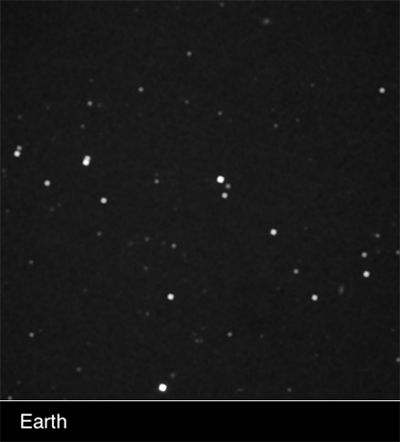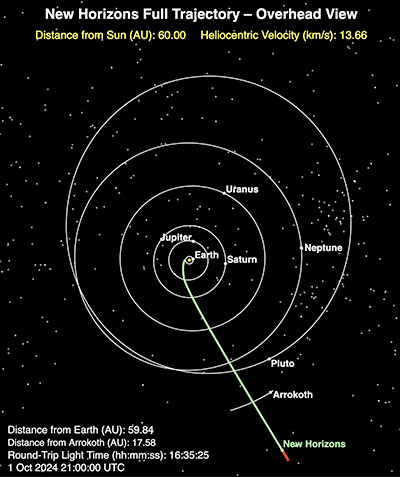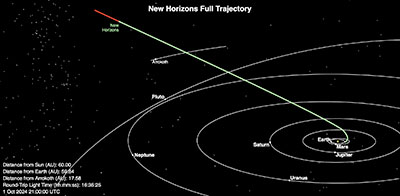|
|

|
|
Author
|
Topic: [Discuss] New Horizons to Pluto, Arrokoth
|
Glint
Member Posts: 1146
From: New Windsor, Maryland USA
Registered: Jan 2004
|
 posted 01-02-2019 09:03 PM
posted 01-02-2019 09:03 PM
   
The late Tom Van Flandern appears to have been 100% correct when he predicted in the early 1990s, prior to any other models contorting themselves to fit them in, that multiple body systems in the asteroid belts would not be the exception, but would be the norm. |
Robert Pearlman
Editor Posts: 53241
From: Houston, TX
Registered: Nov 1999
|
 posted 11-12-2019 12:48 PM
posted 11-12-2019 12:48 PM
   
Kuiper Belt object 2014 MU69, previously nicknamed "Ultima Thule," has now been formally named "Arrokoth." In a fitting tribute to the farthest flyby ever conducted by spacecraft, the Kuiper Belt object 2014 MU69 has been officially named Arrokoth, a Native American term meaning "sky" in the Powhatan/Algonquian language.With consent from Powhatan Tribal elders and representatives, NASA's New Horizons team – whose spacecraft performed the record-breaking reconnaissance of Arrokoth four billion miles from Earth – proposed the name to the International Astronomical Union and Minor Planets Center, the international authority for naming Kuiper Belt objects. The name was announced at a ceremony today (Nov. 12) at NASA Headquarters in Washington, DC. |
SpaceAholic
Member Posts: 5397
From: Sierra Vista, Arizona
Registered: Nov 1999
|
 posted 06-12-2020 09:53 AM
posted 06-12-2020 09:53 AM
   
NASA release NASA's New Horizons Conducts the First Interstellar Parallax ExperimentFor the first time, a spacecraft has sent back pictures of the sky from so far away that some stars appear to be in different positions than we'd see from Earth. More than four billion miles from home and speeding toward interstellar space, NASA's New Horizons has traveled so far that it now has a unique view of the nearest stars. "It's fair to say that New Horizons is looking at an alien sky, unlike what we see from Earth," said Alan Stern, New Horizons principal investigator from Southwest Research Institute (SwRI) in Boulder, Colorado. "And that has allowed us to do something that had never been accomplished before — to see the nearest stars visibly displaced on the sky from the positions we see them on Earth." On April 22-23, the spacecraft turned its long-range telescopic camera to a pair of the "closest" stars, Proxima Centauri and Wolf 359, showing just how they appear in different places than we see from Earth. Scientists have long used this "parallax effect" – how a star appears to shift against its background when seen from different locations — to measure distances to stars. An easy way to see parallax is to place one finger at arm's length and watch it jump back and forth when you view it successively with each eye. Similarly, as Earth makes it way around the Sun, the stars shift their positions. But because even the nearest stars are hundreds of thousands of times farther away than the diameter of Earth's orbit, the parallax shifts are tiny, and can only be measured with precise instrumentation. "No human eye can detect these shifts," Stern said.  Above: This two-frame animation of Proxima Centauri blinks back and forth between New Horizons and Earth images of each star, clearly illustrating the different view of the sky New Horizons has from its deep-space perch. But when New Horizons images are paired with pictures of the same stars taken on the same dates by telescopes on Earth, the parallax shift is instantly visible. The combination yields a 3D view of the stars "floating" in front of their background star fields. "The New Horizons experiment provides the largest parallax baseline ever made — over 4 billion miles — and is the first demonstration of an easily observable stellar parallax," said Tod Lauer, New Horizons science team member from the National Science Foundation's National Optical-Infrared Astronomy Research Laboratory who coordinated the parallax demonstration. "The New Horizons spacecraft is truly a mission of firsts, and this demonstration of stellar parallax is no different" said Kenneth Hansen, New Horizons program scientist at NASA Headquarters in Washington. "The New Horizons spacecraft continues to speed away from Earth toward interstellar space and is continuing to return exciting new data for planetary science." Working in Stereo Lauer, New Horizons Deputy Project Scientist John Spencer, of SwRI, and science team collaborator, astrophysicist, Queen guitarist and stereo imaging enthusiast Brian May created the images that clearly show the effect of the vast distance between Earth and the two nearby stars. "It could be argued that in astro-stereoscopy — 3D images of astronomical objects – NASA's New Horizons team already leads the field, having delivered astounding stereoscopic images of both Pluto and the remote Kuiper Belt object Arrokoth," May said. "But the latest New Horizons stereoscopic experiment breaks all records. These photographs of Proxima Centauri and Wolf 359 – stars that are well-known to amateur astronomers and science fiction aficionados alike — employ the largest distance between viewpoints ever achieved in 180 years of stereoscopy!" The companion images of Proxima Centauri and Wolf 359 were provided by the Las Cumbres Observatory, operating a remote telescope at Siding Spring Observatory in Australia, and astronomers John Kielkopf, University of Louisville, and Karen Collins, Harvard and Smithsonian Center for Astrophysics, operating a remote telescope at Mt. Lemmon Observatory in Arizona.  Above: This two-frame animation of Wolf 359 blinks back and forth between New Horizons and Earth images of each star, clearly illustrating the different view of the sky New Horizons has from its deep-space perch. "The professional and amateur astronomy communities had been waiting to try this, and were very excited to make a little space exploration history," said Lauer. "The images collected on Earth when New Horizons was observing Proxima Centauri and Wolf 359 really exceeded my expectations." Download the images (and learn more about creating and posting your own parallax perspectives). An Interstellar Navigation First Throughout history, navigators have used measurements of the stars to establish their position on Earth. Interstellar navigators can do the same to establish their position in the galaxy, using a technique that New Horizons has demonstrated for the first time. While radio tracking by NASA's Deep Space Network is far more accurate, its first use is a significant milestone in what may someday become human exploration of the galaxy. At the time of the observations, New Horizons was more than 4.3 billion miles (about 7 billion kilometers) from Earth, where a radio signal, traveling at the speed of light, needed just under 6 hours and 30 minutes to reach home. |
SpaceAholic
Member Posts: 5397
From: Sierra Vista, Arizona
Registered: Nov 1999
|
 posted 11-06-2020 09:23 AM
posted 11-06-2020 09:23 AM
   
Principal Investigator Alan Stern provides an update about the plans afoot: New Horizons is healthy and continuing to send data back from the flyby of the Kuiper Belt object (KBO) Arrokoth back in late 2018 and early 2019, even as it speeds deeper into the Kuiper Belt and farther from the Earth and the Sun.By next spring, New Horizons will be 50 times as far from the Sun as the Earth is – only the fifth operating spacecraft to reach that distance. But as far as we've come, there's much more ahead! We plan to upgrade the spacecraft system and instrument software aboard New Horizons to enhance the mission's scientific capabilities and to search for new KBO targets to study or even fly by. I'll describe both of those plans just below. But before I do that, I want to share some other news: NASA has approved my nomination of five new co-investigators on our mission science team! All five of these talented scientists worked on our Arrokoth flyby, and most were involved in the Pluto flyby as well. Their appointment to co-investigator status is recognition of their growing role on the team and their hard work and productivity over the few past years. The five individuals are: planetary astronomer Susan Benecchi, of the Planetary Science Institute: planetary geologist Ross Beyer, of the SETI Institute; planetary scientist Carly Howett, of Southwest Research Institute; planetary physicist Orkan Umurhan, of the SETI Institute; and planetary geologist Oliver White, of the SETI Institute. I also want to share the news that we are now regularly posting some of the many new mission science results being published in summary form on our website; you can find these under News and then Discovery Stories. I hope you enjoy them, and we'll keep 'em coming in the years ahead! Back to those flight software enhancements: the new software will expand the science-gathering capabilities of four of the seven instruments aboard New Horizons by late next year, and enable us to eventually improve the capabilities of two other instruments as well. These improvements include faster cadence measurements of the charged particle environment of the Kuiper Belt and the Sun's distant heliosphere, as well as the ability to co-add images taken on New Horizons to improve their signal-to-noise ratio – making it easier to spot the objects we're imaging! -- and greatly reduce the time it takes to send these images back to Earth. We're also turning our radio science experiment (REX) into a dust-impact detector to complement our Student Dust Counter, and improving the sky-mapping capabilities for both REX and our ultraviolet mapping spectrometer called Alice. Software engineers are already working on most of these improvements. The first will be ready to send to New Horizons early next year. Most others will be complete and finished ground testing by mid-summer. All in all, we'll be generating new science with virtually all of these new capabilities by late 2021, and I can't wait! The other update I want to provide is about the results of our collaboration with the giant Japanese Subaru astronomical observatory located on Mauna Kea in Hawaii. The Subaru telescope is the best tool on this planet for finding new KBOs for New Horizons to study or even fly by. The reason for this is that Subaru is one of the very largest telescopes on Earth and is equipped with the largest wide-field-of-view imager of any of the giant telescopes currently operating. This year we partnered with the Subaru Observatory and the National Astronomical Observatory of Japan, Subaru's parent organization, to search for new KBOs along our path. Subaru provided us with about a week's worth of observing nights in each of May, June and August, along with some follow-up time in October. The results are spectacular: about 75 new KBOs found in the direction New Horizons is traveling. Between 15 and 20 will pass close enough to New Horizons to be scientifically observed, beginning this December. Although none of these KBOs are close enough for us to reach for a close flyby like we did at Arrokoth, the science we can do even from a distance will produce new results on KBO surface properties, shapes, rotational periods, and close-in moons that could not be achieved any other way. We've already asked for more time on Subaru in 2021 and expect to detect still more KBOs to study if that observing time is approved. Perhaps (if we get lucky) we'll even snag a new flyby target if we can find a KBO that's within reach of our current fuel supply (about an eighth of a tank, which was about the same amount it cost to get to Arrokoth). And if we don't find that KBO in 2021, we'll search again in 2022 — the potential for groundbreaking discoveries with another flyby is too great not to keep searching! And remember, it took us about four years of careful searching to find Arrokoth back in 2014 –we are in this for the long game. And with that, I'll conclude this PI report, my last for 2020. But stay tuned: I'll have a special report in January, when we'll be celebrating the 15th anniversary of New Horizons' launch. In the meantime, I hope you'll keep on exploring — just as we do! |
SpaceAholic
Member Posts: 5397
From: Sierra Vista, Arizona
Registered: Nov 1999
|
 posted 11-19-2020 09:43 AM
posted 11-19-2020 09:43 AM
   
Researchers with NASA's New Horizons say they've been able to determine that space isn't pitch black after all. The group has posted their work online, and it will soon appear in the Astrophysical Journal."They're saying that there's as much light outside of galaxies as there is inside of galaxies, which is a pretty tough pill to swallow, frankly," notes Michael Zemcov, an astrophysicist at Rochester Institute of Technology, who was not part of the research team. A few years ago, Zemcov and some colleagues analyzed New Horizons data in a similar way. Using fewer images, they made a less precise measurement, but it was still compatible with the current results. He says for 400 years, astronomers have been studying visible light and the sky in a serious way and yet somehow apparently "missed half the light in the universe." |
Blackarrow
Member Posts: 3751
From: Belfast, United Kingdom
Registered: Feb 2002
|
 posted 11-19-2020 05:29 PM
posted 11-19-2020 05:29 PM
  
As I recall, the New Horizons project was sold as "much more than just a Pluto flyby." It is very gratifying to see that having performed a spectacularly successful investigation of the Pluto system, New Horizons is indeed proving its worth as a Kuiper Belt investigator. I await further developments with keen interest. |
Robert Pearlman
Editor Posts: 53241
From: Houston, TX
Registered: Nov 1999
|
 posted 04-15-2023 11:37 AM
posted 04-15-2023 11:37 AM
   
NASA's Science Mission Directorate is soliciting input on turning the New Horizons spacecraft into a heliospheric science probe much sooner than mission planners intended. If that happens, it will stop further planned planetary exploration of objects in that distant regime of the Solar System, reports Universe Today. The New Horizons team is working to get the planetary component extended. They also want to keep experienced mission scientists in place. Although the RFI doesn't state it directly, the wording seems to suggest that the Science Mission Directorate is looking to replace the current science team with new groups of scientists who will propose heliophysics science for the spacecraft moving forward. These researchers would not be as familiar with the mission instruments. Something like this has never been done to any spacecraft team before, said [Principal Investigator Alan] Stern. He fears that if new people are brought in to run the mission, the current team will be sent packing, unfunded and unaffiliated with the spacecraft they worked to build, launch, and operate. And, the loss to science is incalculable. "If they shut it down as a planetary mission, it will be the end of Kuiper Belt exploration for several decades," he said. "Cutting us off prematurely is exactly counter to what the Decadal Survey recommended." |
Robert Pearlman
Editor Posts: 53241
From: Houston, TX
Registered: Nov 1999
|
 posted 10-01-2024 06:17 PM
posted 10-01-2024 06:17 PM
   
From New Horizons' PI Alan Stern (via X): Woohoo! NASA's New Horizons spacecraft is, as of today [Oct. 2], 60 times as far from the Sun as Earth is — that's almost two times as far as we were when we intercepted Pluto! And we're continuing outward at about 300 million miles/year as we explore the Sun's outer heliosphere and the Kuiper Belt!  
| |
Contact Us | The Source for Space History & Artifacts
Copyright 1999-2024 collectSPACE. All rights reserved.

Ultimate Bulletin Board 5.47a
|
|

|
 advertisement advertisement

|















